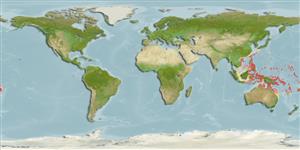Classification / Names
Common names from other countries
Main reference
Size / Weight / Age
Max length : 10.3 cm SL male/unsexed; (Ref. 57884); 10.0 cm SL (female)
Environment
Marine; reef-associated; depth range 5 - 25 m (Ref. 34024)
Climate / Range
Tropical, preferred ?
Distribution
Western Central Pacific: Great Barrier Reef north of 16°S and in Papua New Guinea south of 5°S; westwards in Maluku, Indonesia; along the Louisiade Archipelago to the Solomon Islands including Santa Cruz Islands and Vanuatu.
Countries | FAO areas | Ecosystems | Occurrences | Introductions
Short description
Dorsal
soft rays
(total): 74-85;
Anal
soft rays: 60 - 69;
Vertebrae: 43 - 45. The species is characterized by the following: vertebrae 11+32-34=43-45, dorsal fin rays 74-85 (mostly >77), anal fin rays 60-69, D/V 6 (rarely 7); large eyes (2.1-3.4% SL); outer pseudoclasper with broad hook-shaped extension, with rounded tip, slightly bent outwards; inner pseudoclasper short, joined to outer pseudoclasper anteriorly, supporter with anteriorly oriented small hook, and with a wide thin flap at posterior-distal margin; scale patch on cheek with 7-9 scale rows on upper cheek, many scales on operculum above opercular spin (7-16 scales in 2-4 rows), in very large specimens additional scale patch below opercular spine (4-12); head profile is moderately slender; otolith length sulcus length 1.9-2.0, sulcus slightly inclined (Ref. 57884).
IUCN Red List Status (Ref. 115185)
Threat to humans
Harmless
Human uses
Fisheries: of no interest
More information
ReferencesAquacultureAquaculture profileStrainsGeneticsAllele frequenciesHeritabilityDiseasesProcessingMass conversion
Tools
Special reports
Download XML
Internet sources
Estimates of some properties based on models
Phylogenetic diversity index
PD50 = 0.5000 many relatives (e.g. carps) 0.5 - 2.0 few relatives (e.g. lungfishes)
Trophic Level
3.3 ±0.5 se; Based on size and trophs of closest relatives
Resilience
Low, minimum population doubling time 4.5 - 14 years (Assuming Fec < 100)
Vulnerability
Low vulnerability (20 of 100)
Price category
